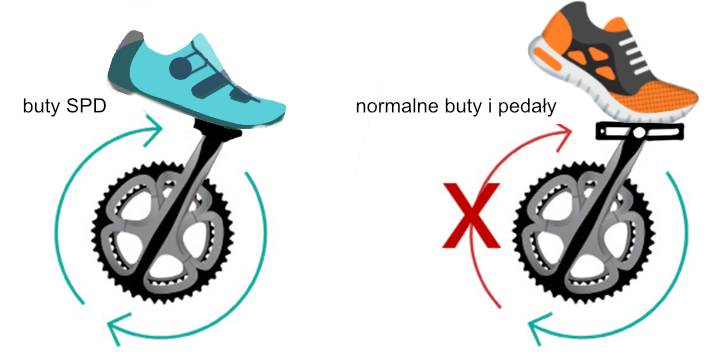
Apparently, the cyclist’s biggest fear is that after his death, his wife will sell the bikes for what he said they cost. This popular joke carries a lot of truth, because hiding the budget for sports equipment in a relationship is nothing unusual. Anyone who thought that it was enough to buy a bike to join a group of fellow cycling buddies, learned painfully that this is only the tip of the iceberg, hiding a multitude of a variety of additional equipment and accessories. One of the first things that the fans of two wheels will pay attention to (and advise buying) are SPD shoes and dedicated pedals. A quick review of the prices of this type of solution can knock you off your feet (the price of SPD pedals starts at PLN 150 and can reach up to PLN 5,500 when Garmin Rally XC200 with power measurement catch our eye, and, for example, Fizik shoes with a carbon insert are another PLN 1,800). The question remains, does this equipment offer us something beyond a ‘professional cycling look’ ?
Fortunately, to assess the impact of clip-on pedals along with professional footwear, and thus the validity of a new purchase, we can use the analysis of research conducted in this area.
What does research tell me about this topic ?
This issue was dealt with by two scientists from Colorado University – Asher Straw and Rodger Krama – who studied the impact of 3 types of footwear with pedals (flat shoes + flat pedals, flat shoes + pedals with toe clips, cycling shoes with cleats) on the generated power (Straw & Kram, 2016 ). For this purpose, 11 elite cyclists were recruited, who completed 3 consecutive 5-minute trials in which they were forced to generate work of 50, 100 and 150 W at a 90 rpm cadence on a stationary bike (Monark). All lovers of technological innovations may be surprised by the fact that no statistically significant differences were noticed between the influence of the tested accessories on the power generated on the bike. The researchers concluded that the only benefits of clip-on shoes with dedicated pedals are comfort and safety.

But that’s impossible!
A common argument for the supposed advantage of clip-on shoes is the ability to generate power both when pushing (extending the legs) and pulling the pedal (flexing), unlike the shoes without fastenings. Research conducted by a team at the University of South Carolina, during which the work put into pedaling over a distance of 40 km was measured, showed that the pull-up action is less than 1.5% of the generated power (Kautz et al., 2016). Furthermore, focusing on increasing the amount of pulling-up in the pedaling process may worsen the effort economy (Mornieux et al., 2008).

But the carbon insert has to make a difference!
Another study tested high-end shoes (Specialized) with 3 different flex insoles (Torch 1.0, Torch 3.0 and S-Works 7) (Hurt & Kram, 2020). 24 elite cyclists were asked to perform 9 (3 per insole) 50-meter sprints up a hill with a constant slope of 4.9%. The difference in energy loss (dissipation) due to foot pressure on the pedal between the insoles was <0.1%. As you can guess, no statistically significant differences were found between the 3 tested insoles.
It is worth remembering that the differences in the stiffness of the tested inserts were not large, which made it difficult to find any significant differences. The situation may be quite different when we compare, in sprint conditions, soft running shoes with cycling shoes clipped into the pedals. Burns and Kram noted the loss of up to 27.6% of power by dissipating it in the soft sole of running shoes (Burns & Kram, 2020).
Summary
Cinderella, in an alternative version of the fairy tale, was quoted as saying that “nothing improves the mood like a new pair of shoes.” The statement is valid even today, and the purchase of a new bicycle can be an additional impulse to review the offers of manufacturers of specialized sports equipment, including footwear. Fortunately, as research shows, these shoes don’t have to be high-end shoes. They don’t even have to be clip-on shoes when it comes to power generation or indoor spinning. Just make sure they’re not too soft. On the other hand, an important advantage of SPD shoes is pedaling comfort and bike control (you can, for example, do a “bunny hop” over a pothole in the road). An intermediate solution may be toe clips screwed to the pedals, which protect the foot from slipping, improve bike control without generating high costs. Everything will be verified by the first, larger climb anyway, because what you don’t have in your legs, you won’t make up with the ‘look’
Bibliography
Burns, A. C., & Kram, R. (2020). The effect of cycling shoes and the shoe-pedal interface on maximal mechanical power output during outdoor sprints.12(3), 185–192.
Hurt, J. W., & Kram, R. (2020). No effect of cycling shoe sole stiffness on sprint performance. Https://Doi.Org/10.1080/19424280.2020.1825533, 13(1), 69–77.
Kautz, S. A., Feltner, M. E., Coyle, E. F., & Baylor, A. M. (2016). The Pedaling Technique of Elite Endurance Cyclists: Changes with Increasing Workload at Constant Cadence. International Journal of Sport Biomechanics, 7(1), 29–53.
Mornieux, C., Stapelfeldt, B., Collhofer, A., & Belli, A. (2008). Effects of pedal type and pull-up action during cycling. International Journal of Sports Medicine, 29(10), 817–822.
Straw, A. H., & Kram, R. (2016). Effects of shoe type and shoe–pedal interface on the metabolic cost of bicycling. Http://Dx.Doi.Org/10.1080/19424280.2016.1140817, 8(1), 19–22.
daily workout and nutritional advice
to maximise performance
exclusive discounts and offers
Be the first to hear about new products
Fitness Authority® Sp. z o.o.
Konna 40, Otomin – Poland
NIP: 957 103 70 01
KRS: 0000355208
P: +48 58 522-07-56
E-mail: contact@vitarade.com